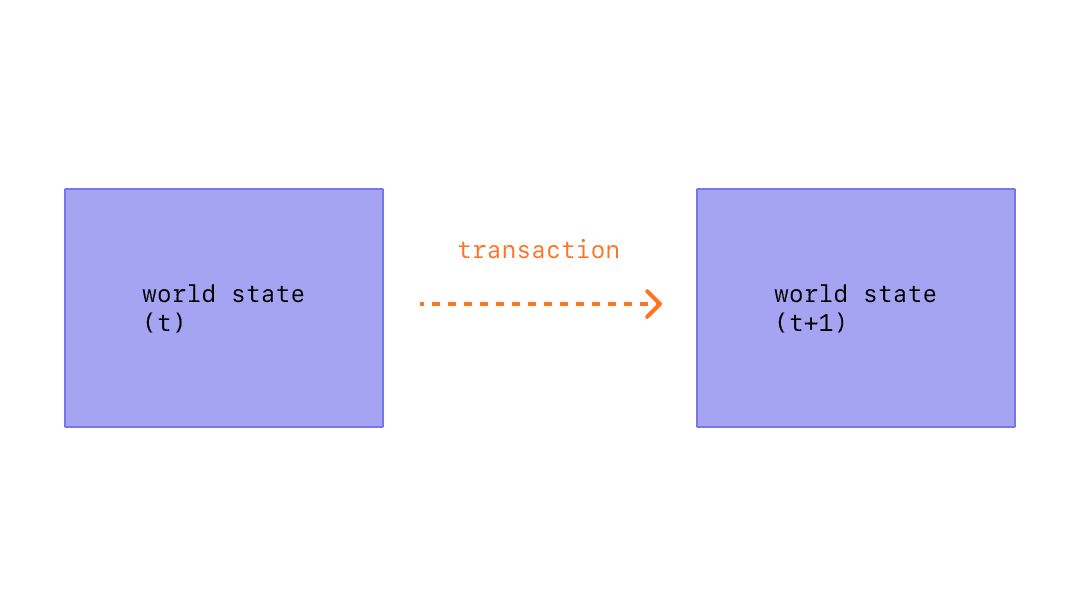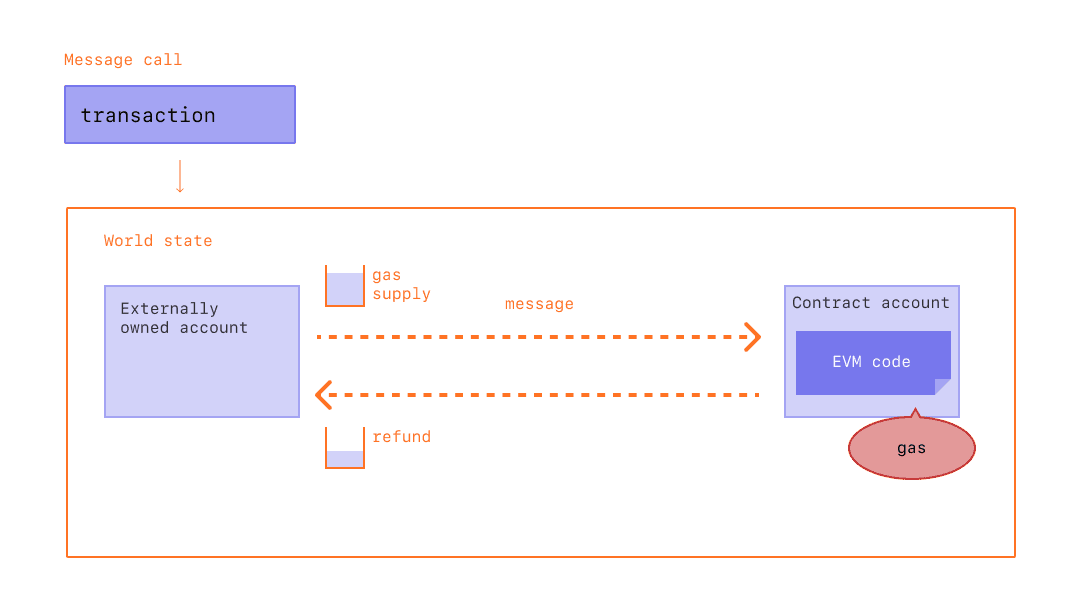Transactions
Transactions are cryptographically signed instructions from accounts. An account will initiate a transaction to update the state of the Ethereum network. The simplest transaction is transferring ETH from one account to another.
Prerequisites
To help you better understand this page, we recommend you first read Accounts and our introduction to Ethereum.
What's a transaction?
An Ethereum transaction refers to an action initiated by an externally-owned account, in other words an account managed by a human, not a contract. For example, if Bob sends Alice 1 ETH, Bob's account must be debited and Alice's must be credited. This state-changing action takes place within a transaction.
 Diagram adapted from Ethereum EVM illustrated
Diagram adapted from Ethereum EVM illustrated
Transactions, which change the state of the EVM, need to be broadcast to the whole network. Any node can broadcast a request for a transaction to be executed on the EVM; after this happens, a miner will execute the transaction and propagate the resulting state change to the rest of the network.
Transactions require a fee and must be mined to become valid. To make this overview simpler we'll cover gas fees and mining elsewhere.
A submitted transaction includes the following information:
recipient– the receiving address (if an externally-owned account, the transaction will transfer value. If a contract account, the transaction will execute the contract code)signature– the identifier of the sender. This is generated when the sender's private key signs the transaction and confirms the sender has authorised this transactionvalue– amount of ETH to transfer from sender to recipient (in WEI, a denomination of ETH)data– optional field to include arbitrary datagasLimit– the maximum amount of gas units that can be consumed by the transaction. Units of gas represent computational stepsmaxPriorityFeePerGas- the maximum amount of gas to be included as a tip to the minermaxFeePerGas- the maximum amount of gas willing to be paid for the transaction (inclusive ofbaseFeePerGasandmaxPriorityFeePerGas)
Gas is a reference to the computation required to process the transaction by a miner. Users have to pay a fee for this computation. The gasLimit, and maxPriorityFeePerGas determine the maximum transaction fee paid to the miner. More on Gas.
The transaction object will look a little like this:
1{2 from: "0xEA674fdDe714fd979de3EdF0F56AA9716B898ec8",3 to: "0xac03bb73b6a9e108530aff4df5077c2b3d481e5a",4 gasLimit: "21000",5 maxFeePerGas: "300"6 maxPriorityFeePerGas: "10"7 nonce: "0",8 value: "10000000000",9}10Show allCopy
But a transaction object needs to be signed using the sender's private key. This proves that the transaction could only have come from the sender and was not sent fraudulently.
An Ethereum client like Geth will handle this signing process.
Example JSON-RPC call:
1{2 "id": 2,3 "jsonrpc": "2.0",4 "method": "account_signTransaction",5 "params": [6 {7 "from": "0x1923f626bb8dc025849e00f99c25fe2b2f7fb0db",8 "gas": "0x55555",9 "maxFeePerGas": "0x1234",10 "maxPriorityFeePerGas": "0x1234",11 "input": "0xabcd",12 "nonce": "0x0",13 "to": "0x07a565b7ed7d7a678680a4c162885bedbb695fe0",14 "value": "0x1234"15 }16 ]17}18Show allCopy
Example response:
1{2 "jsonrpc": "2.0",3 "id": 2,4 "result": {5 "raw": "0xf88380018203339407a565b7ed7d7a678680a4c162885bedbb695fe080a44401a6e4000000000000000000000000000000000000000000000000000000000000001226a0223a7c9bcf5531c99be5ea7082183816eb20cfe0bbc322e97cc5c7f71ab8b20ea02aadee6b34b45bb15bc42d9c09de4a6754e7000908da72d48cc7704971491663",6 "tx": {7 "nonce": "0x0",8 "maxFeePerGas": "0x1234",9 "maxPriorityFeePerGas": "0x1234",10 "gas": "0x55555",11 "to": "0x07a565b7ed7d7a678680a4c162885bedbb695fe0",12 "value": "0x1234",13 "input": "0xabcd",14 "v": "0x26",15 "r": "0x223a7c9bcf5531c99be5ea7082183816eb20cfe0bbc322e97cc5c7f71ab8b20e",16 "s": "0x2aadee6b34b45bb15bc42d9c09de4a6754e7000908da72d48cc7704971491663",17 "hash": "0xeba2df809e7a612a0a0d444ccfa5c839624bdc00dd29e3340d46df3870f8a30e"18 }19 }20}21Show allCopy
- the
rawis the signed transaction in Recursive Length Prefix (RLP) encoded form - the
txis the signed transaction in JSON form
With the signature hash, the transaction can be cryptographically proven that it came from the sender and submitted to the network.
Types of transactions
On Ethereum there are a few different types of transactions:
- Regular transactions: a transaction from one wallet to another.
- Contract deployment transactions: a transaction without a 'to' address, where the data field is used for the contract code.
On gas
As mentioned, transactions cost gas to execute. Simple transfer transactions require 21000 units of Gas.
So for Bob to send Alice 1 ETH at a baseFeePerGas of 190 gwei and maxPriorityFeePerGas of 10 gwei, Bob will need to pay the following fee:
1(190 + 10) * 21000 = 4,200,000 gwei2--or--30.0042 ETH4
Bob's account will be debited -1.0042 ETH
Alice's account will be credited +1.0 ETH
The base fee will be burned -0.003735 ETH
Miner keeps the tip +0.000197 ETH
Gas is required for any smart contract interaction too.
 Diagram adapted from Ethereum EVM illustrated
Diagram adapted from Ethereum EVM illustrated
Any gas not used in a transaction is refunded to the user account.
Transaction lifecycle
Once the transaction has been submitted the following happens:
- Once you send a transaction, cryptography generates a transaction hash:
0x97d99bc7729211111a21b12c933c949d4f31684f1d6954ff477d0477538ff017 - The transaction is then broadcast to the network and included in a pool with lots of other transactions.
- A miner must pick your transaction and include it in a block in order to verify the transaction and consider it "successful".
- You may end up waiting at this stage if the network is busy and miners aren't able to keep up.
- Your transaction will also get a block confirmation number. This is the number of blocks created since the block that your transaction was included in. The higher the number, the greater the certainty that the transaction was processed and recognised by the network. This is because sometimes the block your transaction was included in may not have made it into the chain.
- The larger the block confirmation number the more immutable the transaction is. So for higher value transactions, more block confirmations may be desired.
A visual demo
Watch Austin walk you through transactions, gas, and mining.
Further reading
Know of a community resource that helped you? Edit this page and add it!